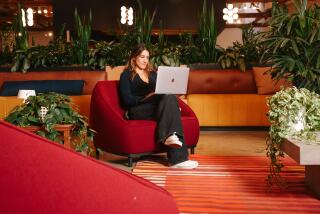The Down Side of Working at Home
- Share via
Working at home via computer, often considered a technological-age boon for women, especially those with children, has its down side.
For professional workers--who are usually well-paid, can afford child care when they are busy, may frequently have business contacts outside the home and have control over their own workloads--working electronically from home can be wonderful.
However, for clerical workers, who constitute the vast majority of women using computer terminals, working at home instead of in an office may result in “marginalization” of their jobs--full time turned into part time, reduced wages, fewer or no fringe benefits and limited opportunity for advancement or training.
These are the conclusions of the U.S. House Committee on Government Operations in a report titled “Home-Based Clerical Workers: Are They Victims of Exploitation?” The answer was yes, and the report was approved unanimously by the House in late July. Among those whose research contributed to House hearings on the subject were 9to5, National Organization of Working Women and the Service Employees International Union.
Not Dependable Income
The issue is a large one. About 15,000 clerical workers now work at home on electronic equipment; predictions are that as many as 10 million could be doing so by the early 1990s.
“Most home workers are paid considerably less than their office counterparts,” the report said. The only visible part of their work is what they produce and send, unlike workers who are paid for all of the time they spend in the office which includes time spent setting up a task, correcting work, printing, collating and interacting with co-workers. The report also said that home clerical workers rarely have a guaranteed or stable flow of work and thus do not have a dependable income.
In addition, a clerical worker out of sight is often out of mind. “Clerical home workers often suffer from isolation and loss of opportunities for career advancement by missing out on training, on the benefits of networking and by their invisibility when promotions are considered,” the report said.
Regarding benefits, which constitute as much as 30% of payrolls, the Committee on Government Operations recommended data collection to improve enforcement of the Fair Labor Standards Act so that employers will not misclassify home workers as independent contractors when they are, in fact, employees, a common abuse that enables an employer to avoid the expense of Social Security, workers’ compensation, unemployment insurance, income tax withholding, health insurance, vacation and sick leaves and pension contributions.
Expansion of Child Care
Rather than viewing work at home as a solution to the child care problem, the committee recommended that child care services “be vastly expanded so that women may make free and unforced choices as to whether, when and under what terms they will work at home. Women should not be compelled to struggle with individual solutions to the major societal problems of day care.”
In their report on the subject, 9to5 and the Service Employees Union pointed out that “home work has been promoted as a way for clericals who are mothers to manage two jobs at the same time” and that “what is often touted as a great way to have it all usually leaves the worker with very little indeed.”
According to another report from similar sources, working in an office isn’t all that great either. On July 22, the day after the House endorsed the report on the bad news about working at home, the U.S. General Accounting Office issued a report that showed that only $14.2 million--or about a penny a year per American office worker--was spent on researching office health hazards between 1981 and 1986.
“The figure is outrageous,” said Karen Nussbaum, executive director of 9to5, in her organization’s response to the finding. “This is particularly troubling, she said, “when you consider that clerical work is the largest single job category.” There are 33 million officer workers in the United States, and one of every three working women is an office worker.
That office work is clean and safe is “a myth,” Nussbaum said, citing hazards including indoor air pollution, toxic chemicals used in copying machines, a high rate of stress in office work and suspected hazards, including vision and orthopedic problems and possible dangers to pregnant women and their babies linked to use of video display terminals.
Nussbaum called for a serious commitment to further study of suspected office health hazards.
More to Read
Inside the business of entertainment
The Wide Shot brings you news, analysis and insights on everything from streaming wars to production — and what it all means for the future.
You may occasionally receive promotional content from the Los Angeles Times.










